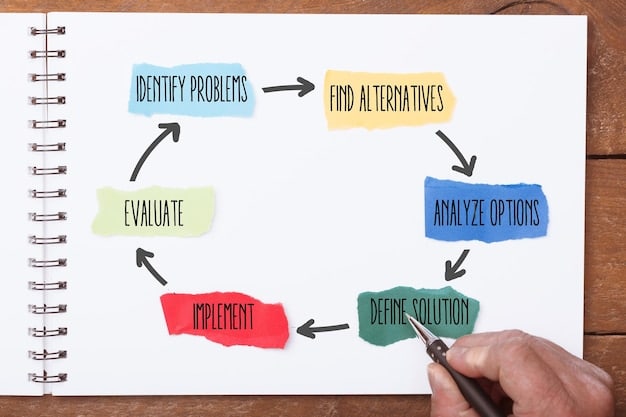Navigating the New January 2025 E-commerce Security Updates: A US Business Guide

The January 2025 e-commerce platform security updates will significantly impact US businesses, requiring them to enhance data protection measures, update security protocols, and ensure compliance with evolving regulations to safeguard customer trust and avoid potential financial and legal repercussions.
The digital marketplace is always evolving, and with that evolution comes new challenges and requirements to keep your business and customers safe. As we approach January 2025, significant security updates to e-commerce platforms are on the horizon. This article will explore how the new January 2025 e-commerce platform security updates will impact your US business, helping you to understand, prepare, and thrive in the changing landscape.
Understanding the Impending E-commerce Security Updates
To navigate the forthcoming changes, it’s vital to understand precisely what these updates entail. These updates are not merely minor tweaks but significant overhauls designed to counteract sophisticated cyber threats and protect sensitive consumer data. Understanding their essence is the first step toward ensuring your business remains secure and compliant.
Key Changes in the Security Updates
These updates focus on bolstering authentication processes, enhancing encryption standards, and implementing stricter data access controls. They are designed to mitigate risks such as data breaches, fraud, and unauthorized access, ensuring a safer online environment for both businesses and consumers.
Why These Updates Are Necessary
E-commerce platforms are prime targets for cyberattacks. The increasing sophistication of these attacks necessitates stronger, more proactive security measures. By updating their security protocols, platforms aim to stay ahead of potential threats, offering a secure environment for businesses to operate and consumers to shop with confidence. These updates are essential to maintaining trust in the digital marketplace and protecting the financial and personal information of users.
- Enhanced Encryption: Improved algorithms to protect data in transit and at rest.
- Multi-Factor Authentication (MFA): Requiring multiple verification methods to prevent unauthorized access.
- Data Access Controls: Limiting access to sensitive information based on user roles and responsibilities.
- Regular Security Audits: Ensuring ongoing compliance and identifying potential vulnerabilities.
Understanding the core changes and the reasons behind them is crucial. These updates aim to create a safer and more reliable e-commerce ecosystem, fostering greater consumer confidence and trust in online transactions.
Assessing the Potential Impact on Your US Business
The forthcoming updates will have a far-reaching impact on US e-commerce businesses. It’s essential to assess these potential impacts methodically to ensure a smooth transition and prevent disruptions. Evaluating the potential consequences allows you to proactively address challenges and identify opportunities for improvement.

Operational Adjustments
Businesses may need to update their existing systems and processes to align with the new security standards. This could involve upgrading software, modifying data handling procedures, and retraining staff. Furthermore, operational adjustments might include reconfiguring payment gateways, updating inventory management systems, and revising customer service protocols to ensure compliance and security at every touchpoint.
Financial Implications
Implementing enhanced security measures often comes with associated costs. Businesses may need to invest in new technologies, security audits, and employee training. These upfront investments, however, can lead to long-term cost savings by mitigating the risk of costly data breaches and potential legal liabilities.
Legal and Compliance Ramifications
Non-compliance with the new security standards can lead to severe penalties, including fines, legal action, and reputational damage. Businesses must ensure they are up-to-date with all relevant regulations and industry best practices. Staying compliant not only avoids penalties but also demonstrates a commitment to protecting customer data, enhancing trust and credibility.
Assessing these impacts is crucial for developing a comprehensive plan to address these upcoming changes. From operational adjustments to financial considerations and legal compliance, a thorough evaluation will help your business adapt effectively.
Steps to Prepare for the 2025 Security Updates
Preparation is key to navigating these changes smoothly. A proactive approach is essential in ensuring your business is ready for the January 2025 security updates. Implementing a step-by-step plan ensures that no critical aspect is overlooked, and your business remains secure and compliant.
Conduct a Thorough Security Audit
Begin by assessing your current security infrastructure. Identify any vulnerabilities and areas that need improvement. A detailed audit will provide a clear picture of your security posture, revealing weaknesses that need immediate attention.
Update Your Systems and Software
Ensure all systems and software are running the latest versions. Patch any known security vulnerabilities to prevent potential exploits. Regular updates reduce the risk of cyberattacks by closing security loopholes and maintaining compatibility with new security standards.
Implement Multi-Factor Authentication
Add an extra layer of security by implementing MFA for all user accounts. This significantly reduces the risk of unauthorized access. Requiring users to verify their identity through multiple channels can prevent breaches even if credentials are stolen or compromised.

- Develop a Compliance Checklist: Ensure all required security measures are in place.
- Train Your Staff: Educate employees on new security protocols and best practices.
- Test Your Systems: Conduct penetration testing to identify potential vulnerabilities.
- Create an Incident Response Plan: Prepare for potential security incidents and data breaches.
Taking these steps will create a robust defense against cyber threats, ensuring your business is well-prepared for the January 2025 security updates. A proactive approach is crucial for maintaining a secure and trustworthy e-commerce platform.
Leveraging Security Technologies and Tools
Investing in the right security technologies and tools is crucial. These tools can automate certain processes, enhance monitoring, and provide real-time protection against threats. Integrating these advanced technologies into your security framework strengthens your defenses and mitigates risks.
Firewalls and Intrusion Detection Systems
Implement robust firewalls to monitor and control network traffic. Use intrusion detection systems to identify and respond to suspicious activities. These tools act as the first line of defense, preventing unauthorized access and detecting potential threats early on.
Data Encryption Tools
Employ data encryption tools to protect sensitive information, both in transit and at rest. Encryption ensures that even if data is intercepted, it remains unreadable to unauthorized parties. This is especially critical for customer data, financial information, and proprietary business data.
Security Information and Event Management (SIEM) Systems
Utilize SIEM systems to aggregate and analyze security logs, providing real-time insights into potential threats. These systems help identify patterns and anomalies that might indicate a security breach, enabling quick response and mitigation.
By carefully selecting and implementing the right technologies, you can enhance your security posture and better protect your e-commerce business from cyber threats. Security technologies and tools play a crucial role in safeguarding your business and maintaining customer trust.
Training and Educating Your Team
Human error is often a major contributing factor to security breaches. Therefore, training and educating your team on the latest security threats and best practices is vitally important. A well-informed team is better equipped to identify and respond to potential security risks, reducing the likelihood of successful attacks.
Regular Security Awareness Training
Conduct regular training sessions to educate employees about phishing scams, malware, and other common cyber threats. Awareness training should cover topics such as identifying suspicious emails, avoiding unsafe websites, and properly handling sensitive data. Reinforcing these practices helps create a security-conscious culture within your organization.
Roles and Responsibilities
Clearly define the roles and responsibilities of each team member regarding security. Ensure that everyone understands their obligations and how to properly handle sensitive information. Defining roles and responsibilities establishes accountability and ensures that all security practices are consistently followed.
Simulated Phishing Exercises
Conduct simulated phishing exercises to test employees’ ability to identify and report phishing attempts. These exercises provide valuable insights into the effectiveness of your training programs and help identify individuals who may need additional support. Realistic simulations prepare your team for real-world threats.
Investing in comprehensive training and education programs can significantly enhance your organization’s security posture by reducing human error and fostering a security-conscious culture. A well-trained team serves as a strong defense against cyber threats.
Staying Updated and Maintaining Continuous Compliance
Cybersecurity is an ongoing process, not a one-time fix. Staying updated with the latest threats and maintaining continuous compliance is critical to protecting your business in the long term. Regular assessments, updates, and employee training are key to maintaining a robust security posture.
Regular Security Assessments
Perform regular security assessments to identify any new vulnerabilities or gaps in your security measures. Assessments should be conducted at least annually or whenever there are significant changes to your systems or processes. Periodic evaluations ensure that your security measures remain effective and aligned with evolving threats.
Monitor Security News and Updates
Stay informed about the latest security threats, vulnerabilities, and best practices. Subscribe to security newsletters, follow industry blogs, and attend relevant webinars to stay up-to-date. Awareness of emerging threats allows you to proactively address potential vulnerabilities and adapt your security measures accordingly.
Update Policies and Procedures
Regularly review and update your security policies and procedures to reflect the latest threats and best practices. Ensure that all employees are aware of any changes and that the policies are consistently enforced. Updated policies and procedures provide a clear framework for secure operations and ensure that all employees are following established protocols.
By staying informed and maintaining continuous compliance, you can safeguard your e-commerce business against evolving cyber threats. A proactive and vigilant approach is essential for protecting your business and building trust with your customers.
| Key Point | Brief Description |
|---|---|
| 🛡️ Security Audits | Assess current infrastructure for vulnerabilities. |
| 🔒 MFA Implementation | Add extra security layer for all user accounts. |
| 📚 Staff Training | Educate employees on security threats and best practices. |
| 🚨 Incident Response | Prepare for potential security incidents. |
Frequently Asked Questions
▼
The updates primarily focus on enhanced data encryption, mandatory multi-factor authentication (MFA), stricter data access controls, and regular, comprehensive security audits.
▼
Small businesses may face initial challenges in terms of cost and implementation but will benefit from reduced risks of data breaches and increased customer trust.
▼
Businesses should conduct security audits, update systems, implement MFA, train staff, and develop an incident response plan to ensure readiness and compliance.
▼
Non-compliance can result in hefty fines, legal action, and significant reputational damage, making it crucial to adhere to the new security requirements.
▼
Security protocols and practices should be updated regularly, at least annually, and whenever there are significant changes or emerging threats to maintain robust protection.
Conclusion
The e-commerce security updates set to roll out in January 2025 represent a significant shift in how US businesses must approach online security. By understanding these changes, assessing their potential impact, and proactively preparing, your business can not only ensure compliance but also enhance customer trust and thrive in an increasingly competitive digital landscape.





